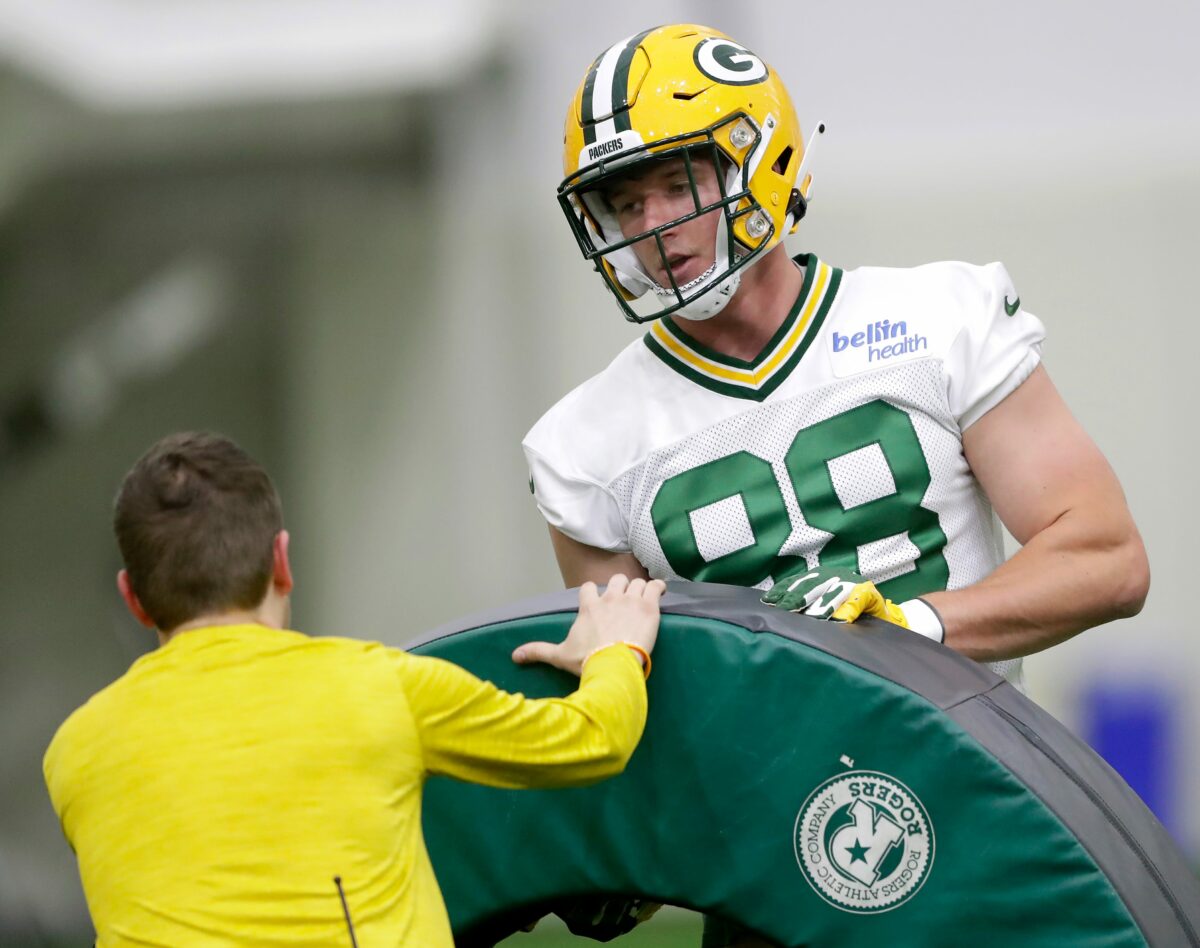[anyclip pubname=”2103″ widgetname=”0016M00002U0B1kQAF_M8036″]
The Green Bay Packers’ new-look tight end room gives them the flexibility to move those players around the formation and have them fill a variety of roles. This, in turn, will allow Matt LaFleur to go deeper into his playbook.
The Packers had a very reliable tight end unit in 2022, with Robert Tonyan and Marcedes Lewis taking the bulk of the snaps on offense. However, each also had a very defined role. Although Tonyan was asked to block, he was primarily on the field to be a pass catcher. And although Lewis caught some passes here and there, he was primarily on the field to block.
These siloed roles led to there being some predictability with the Green Bay offense. When either Tonyan or Lewis was on the field, the defense may not have always known how, but in general, they knew what each player’s responsibility was likely going to be around.
But this year, the Packers hope to have added versatility, along with playmaking — something else that was lacking at tight end last season — with the additions of Tucker Kraft and Luke Musgrave. The dynamic abilities that each brings to the passing game are evident, Musgrave with his speed and Kraft with his YAC ability, but both can impact the run game as blockers, with Brian Gutekunst calling each of them “all-around” tight ends following the draft. Kraft and Musgrave are both very willing blockers, and each has over 500 career run-blocking snaps.
There are mismatches that these two will create for themselves in the passing game with their size and athleticism, but the entire offense will benefit from having them on the field. With both able to lineup inline or from the slot, as well as be a blocker or a threat in the passing game, the Packers’ pre-snap alignment isn’t necessarily going to give away what play they are going to run. This then opens up the playbook for LaFleur and keeps defenses guessing, thus creating opportunities for others within the offense and, hopefully, makes things a bit easier on Jordan Love as well.
“We try to use guys all over the place,” said tight ends coach John Dunn this past week. “Multiple tight end packages and these guys are all in different roles. And the great part about tight end is that it doesn’t have to be just one guy out there. These guys are all used in different roles. When we go out there in a game, they’re all out there and playing different roles.”
With each player being able to take on a variety of roles, there won’t be any duplicate responsibilities on the field – each player can bring something different — and who is doing what could change from series to series or even play-to-play, creating more guesswork for the defense.
Josiah Deguara brings a similar element of unpredictability as the H-back. He can line up really anywhere on the field, and although he was used mostly as a blocker up to this point in his career, we’ve seen him impact the passing game as well. With him being the veteran in the tight end room, his versatility will likely be on display more often this season as he takes on a larger role. Dunn would also add that with Tyler Davis, the Packers can give him a variety of roles as well.
It may take some time, however, before everything just described becomes consistently effective. The tight end position is arguably the second-most difficult transition to make from college to the NFL — behind only quarterback — because of the wide variety of responsibilities that these players have, whether it be blocking like an offensive tackle or running routes like a receiver, and everything that goes into doing those roles effectively. This is why it’s rare that rookie tight ends make a significant impact, and for many, it isn’t until Years 2 or even 3 before they truly hit their stride.
Given the current makeup of the tight end room, and it not looking like there will be a veteran addition to provide some stability, the Packers do not have the luxury of bringing Kraft or Musgrave along slowly. They are going to have to weather the storm of inconsistency, but the hope is that experience shrinks their learning curves and leads to a greater impact sooner by adding some needed unpredictability to the offense.
“There’s no substitute for doing,” said Dunn. “We can teach them, they’re in the classroom, they do a great job learning, they’re smart guys, but what we’re going through now and what we’ll go through in training camp is the ultimate teacher. They have to get out there and they have to do it. They have to do it under pressure. They have to do it full speed. There’s going to be mistakes, right? A lot of learning is through failure, so there’s no substitute for that. I wish there was a magic, ‘Hey this will get you there faster.’ But the greatest part about sport is it really is a process. There’s a mental process to it. We talk about all the time, you’ve got to know what to do, and that’s the phase that we’re in. This is a brand new offense, brand new language, brand new terminology.”
